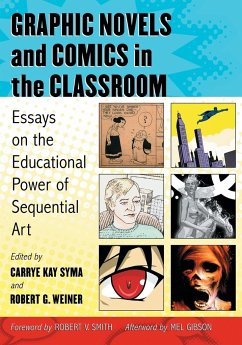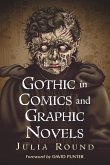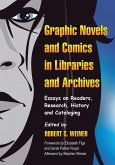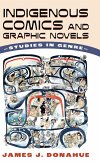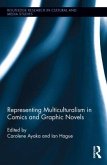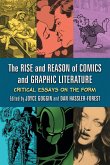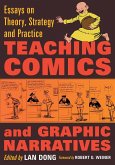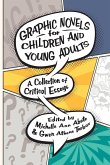Graphic Novels and Comics in the Classroom
Essays on the Educational Power of Sequential Art
Herausgeber: Syma, Carrye Kay; Weiner, Robert G.
Graphic Novels and Comics in the Classroom
Essays on the Educational Power of Sequential Art
Herausgeber: Syma, Carrye Kay; Weiner, Robert G.
- Broschiertes Buch
- Merkliste
- Auf die Merkliste
- Bewerten Bewerten
- Teilen
- Produkt teilen
- Produkterinnerung
- Produkterinnerung
Sequential art combines the visual and the narrative in a way that readers have to interpret the images with the writing. Comics make a good fit with education because students are using a format that provides active engagement. This collection of essays is a wide-ranging look at current practices using comics and graphic novels in educational settings, from elementary schools through college. The contributors cover history, gender, the use of specific graphic novels, practical application and educational theory. Instructors considering this book for use in a course may request an examination copy here.…mehr
Andere Kunden interessierten sich auch für
![Gothic in Comics and Graphic Novels Gothic in Comics and Graphic Novels]() Julia RoundGothic in Comics and Graphic Novels37,99 €
Julia RoundGothic in Comics and Graphic Novels37,99 €![Graphic Novels and Comics in Libraries and Archives Graphic Novels and Comics in Libraries and Archives]() Graphic Novels and Comics in Libraries and Archives44,99 €
Graphic Novels and Comics in Libraries and Archives44,99 €![Indigenous Comics and Graphic Novels Indigenous Comics and Graphic Novels]() James J DonahueIndigenous Comics and Graphic Novels111,99 €
James J DonahueIndigenous Comics and Graphic Novels111,99 €![Representing Multiculturalism in Comics and Graphic Novels Representing Multiculturalism in Comics and Graphic Novels]() Representing Multiculturalism in Comics and Graphic Novels202,99 €
Representing Multiculturalism in Comics and Graphic Novels202,99 €![The Rise and Reason of Comics and Graphic Literature The Rise and Reason of Comics and Graphic Literature]() The Rise and Reason of Comics and Graphic Literature36,99 €
The Rise and Reason of Comics and Graphic Literature36,99 €![Teaching Comics and Graphic Narratives Teaching Comics and Graphic Narratives]() Teaching Comics and Graphic Narratives41,99 €
Teaching Comics and Graphic Narratives41,99 €![Graphic Novels for Children and Young Adults Graphic Novels for Children and Young Adults]() Graphic Novels for Children and Young Adults43,99 €
Graphic Novels for Children and Young Adults43,99 €-
-
-
Sequential art combines the visual and the narrative in a way that readers have to interpret the images with the writing. Comics make a good fit with education because students are using a format that provides active engagement. This collection of essays is a wide-ranging look at current practices using comics and graphic novels in educational settings, from elementary schools through college. The contributors cover history, gender, the use of specific graphic novels, practical application and educational theory. Instructors considering this book for use in a course may request an examination copy here.
Produktdetails
- Produktdetails
- Verlag: McFarland
- Seitenzahl: 300
- Erscheinungstermin: 7. Juni 2013
- Englisch
- Abmessung: 254mm x 178mm x 17mm
- Gewicht: 569g
- ISBN-13: 9780786459131
- ISBN-10: 0786459131
- Artikelnr.: 39044961
- Herstellerkennzeichnung
- Libri GmbH
- Europaallee 1
- 36244 Bad Hersfeld
- gpsr@libri.de
- Verlag: McFarland
- Seitenzahl: 300
- Erscheinungstermin: 7. Juni 2013
- Englisch
- Abmessung: 254mm x 178mm x 17mm
- Gewicht: 569g
- ISBN-13: 9780786459131
- ISBN-10: 0786459131
- Artikelnr.: 39044961
- Herstellerkennzeichnung
- Libri GmbH
- Europaallee 1
- 36244 Bad Hersfeld
- gpsr@libri.de
Carrye Kay Syma is an associate dean and librarian at Texas Tech University. Her research interests include graphic novels and sequential art in education, and women and self-harm. She has been published in Reference Services Review and College and Research Libraries News. Robert G. Weiner is the popular culture librarian at Texas Tech University. His work has been published in the Journal of Popular Culture, Public Library Quarterly, Journal of American Culture, International Journal of Comic Art and Popular Music and Society, and is the author/editor/coeditor of numerous books related to popular culture.
Table of Contents Acknowledgments Foreword (Robert V. Smith) Introduction (Robert G. Weiner and Carrye Kay Syma) Part I: Signi
cance of Graphic Novels and Comics: Then and Using Comics to Teach the Language Arts in the 1940s and 1950s (Carol L. Tilley) Stigmatization, Multimodality and Metaphor: Comics in the Adult English as a Second Language Classroom (Alice Leber-Cook and Roy T. Cook) The Attitudes of Some Students on the Use of Comics in Higher Education (Christina L. Blanch and Thalia M. Mulvihill) Part II: Teaching Graphic Novels and Comics in the Classroom "I can get college credit for reading Batman? That's a joke, right?" Confessions of a Fanboy Professor Teaching Comic Books (David Whitt) "What the-?" Pre-Service Teachers Meet and Grapple Over Graphic Novels in the Classroom (James Bucky Carter) Teaching Intertexuality and Parody Through the Graphic "Supertext": Martin Rowson's The Waste Land (1990) (Kevin M. Flanagan) Part III: Graphic Novels and Comics, Beyond the Text "Remember, remember the
fth of November": Using Graphic Novels to Teach Dystopian Literature (Daniel Ian Rubin) Exploring the Art in Sequential Art: An Art Historical Approach Teaching Comics (Abram Fox) On Teaching Comics and Graphic Novels in the Medieval and Renaissance Classroom (Christina C. Angel) Leagues, Evildoers and Tales of Survival: Graphic Novels and the World History Classroom (Maryanne A. Rhett) "Indisciplinary" Teaching: Comics Studies and Research Writing Pedagogy (Phillip Troutman) Part IV: Speci
c Graphic Novels and Comics and Their Application in Educational Settings Teaching "The Auto-Graphic Novel": Autobiographical Comics and the Ethics of Readership (Rebecca Scherr) Teaching Theory Through Y: The Last Man (Timothy D. Arner) Approaching Literacy Features Through the Graphic Novel Logicomix (Marianna Missiou and Yiannis Koukoulas) Manga, the Atomic Bomb and the Challenges of Teaching Historical Atrocity: Keiji Nakazawa's Barefoot Gen (Jeremy R. Ricketts)174 Information Comics: Risks and Pitfalls (Felix Keller and Dorothea Oechslin) Graphic N-extbooks: A Journey Beyond Traditional Textbooks (Jeremy Short, David Ketchen and Jeff Shelstad) Part V: Cultural Implications of Graphic Novels and Comics Beyond Borders: Teaching Global Awareness Through the Graphic Novel (Lan Dong) The Bene
ts of Writing Comics (Diana Maliszewski) Multicultural Education Through Graphic Novels (Rebecca M. Marrall) "So, Joss, why do you always write these strong women characters?" Using Joss Whedon's Astonishing X-Men to Teach Feminism (Erin Hollis) Sequential Art for Qualitative Research (Marcus B. Weaver-Hightower) Afterword (Mel Gibson) About the Contributors Index
cance of Graphic Novels and Comics: Then and Using Comics to Teach the Language Arts in the 1940s and 1950s (Carol L. Tilley) Stigmatization, Multimodality and Metaphor: Comics in the Adult English as a Second Language Classroom (Alice Leber-Cook and Roy T. Cook) The Attitudes of Some Students on the Use of Comics in Higher Education (Christina L. Blanch and Thalia M. Mulvihill) Part II: Teaching Graphic Novels and Comics in the Classroom "I can get college credit for reading Batman? That's a joke, right?" Confessions of a Fanboy Professor Teaching Comic Books (David Whitt) "What the-?" Pre-Service Teachers Meet and Grapple Over Graphic Novels in the Classroom (James Bucky Carter) Teaching Intertexuality and Parody Through the Graphic "Supertext": Martin Rowson's The Waste Land (1990) (Kevin M. Flanagan) Part III: Graphic Novels and Comics, Beyond the Text "Remember, remember the
fth of November": Using Graphic Novels to Teach Dystopian Literature (Daniel Ian Rubin) Exploring the Art in Sequential Art: An Art Historical Approach Teaching Comics (Abram Fox) On Teaching Comics and Graphic Novels in the Medieval and Renaissance Classroom (Christina C. Angel) Leagues, Evildoers and Tales of Survival: Graphic Novels and the World History Classroom (Maryanne A. Rhett) "Indisciplinary" Teaching: Comics Studies and Research Writing Pedagogy (Phillip Troutman) Part IV: Speci
c Graphic Novels and Comics and Their Application in Educational Settings Teaching "The Auto-Graphic Novel": Autobiographical Comics and the Ethics of Readership (Rebecca Scherr) Teaching Theory Through Y: The Last Man (Timothy D. Arner) Approaching Literacy Features Through the Graphic Novel Logicomix (Marianna Missiou and Yiannis Koukoulas) Manga, the Atomic Bomb and the Challenges of Teaching Historical Atrocity: Keiji Nakazawa's Barefoot Gen (Jeremy R. Ricketts)174 Information Comics: Risks and Pitfalls (Felix Keller and Dorothea Oechslin) Graphic N-extbooks: A Journey Beyond Traditional Textbooks (Jeremy Short, David Ketchen and Jeff Shelstad) Part V: Cultural Implications of Graphic Novels and Comics Beyond Borders: Teaching Global Awareness Through the Graphic Novel (Lan Dong) The Bene
ts of Writing Comics (Diana Maliszewski) Multicultural Education Through Graphic Novels (Rebecca M. Marrall) "So, Joss, why do you always write these strong women characters?" Using Joss Whedon's Astonishing X-Men to Teach Feminism (Erin Hollis) Sequential Art for Qualitative Research (Marcus B. Weaver-Hightower) Afterword (Mel Gibson) About the Contributors Index
Table of Contents Acknowledgments Foreword (Robert V. Smith) Introduction (Robert G. Weiner and Carrye Kay Syma) Part I: Signi
cance of Graphic Novels and Comics: Then and Using Comics to Teach the Language Arts in the 1940s and 1950s (Carol L. Tilley) Stigmatization, Multimodality and Metaphor: Comics in the Adult English as a Second Language Classroom (Alice Leber-Cook and Roy T. Cook) The Attitudes of Some Students on the Use of Comics in Higher Education (Christina L. Blanch and Thalia M. Mulvihill) Part II: Teaching Graphic Novels and Comics in the Classroom "I can get college credit for reading Batman? That's a joke, right?" Confessions of a Fanboy Professor Teaching Comic Books (David Whitt) "What the-?" Pre-Service Teachers Meet and Grapple Over Graphic Novels in the Classroom (James Bucky Carter) Teaching Intertexuality and Parody Through the Graphic "Supertext": Martin Rowson's The Waste Land (1990) (Kevin M. Flanagan) Part III: Graphic Novels and Comics, Beyond the Text "Remember, remember the
fth of November": Using Graphic Novels to Teach Dystopian Literature (Daniel Ian Rubin) Exploring the Art in Sequential Art: An Art Historical Approach Teaching Comics (Abram Fox) On Teaching Comics and Graphic Novels in the Medieval and Renaissance Classroom (Christina C. Angel) Leagues, Evildoers and Tales of Survival: Graphic Novels and the World History Classroom (Maryanne A. Rhett) "Indisciplinary" Teaching: Comics Studies and Research Writing Pedagogy (Phillip Troutman) Part IV: Speci
c Graphic Novels and Comics and Their Application in Educational Settings Teaching "The Auto-Graphic Novel": Autobiographical Comics and the Ethics of Readership (Rebecca Scherr) Teaching Theory Through Y: The Last Man (Timothy D. Arner) Approaching Literacy Features Through the Graphic Novel Logicomix (Marianna Missiou and Yiannis Koukoulas) Manga, the Atomic Bomb and the Challenges of Teaching Historical Atrocity: Keiji Nakazawa's Barefoot Gen (Jeremy R. Ricketts)174 Information Comics: Risks and Pitfalls (Felix Keller and Dorothea Oechslin) Graphic N-extbooks: A Journey Beyond Traditional Textbooks (Jeremy Short, David Ketchen and Jeff Shelstad) Part V: Cultural Implications of Graphic Novels and Comics Beyond Borders: Teaching Global Awareness Through the Graphic Novel (Lan Dong) The Bene
ts of Writing Comics (Diana Maliszewski) Multicultural Education Through Graphic Novels (Rebecca M. Marrall) "So, Joss, why do you always write these strong women characters?" Using Joss Whedon's Astonishing X-Men to Teach Feminism (Erin Hollis) Sequential Art for Qualitative Research (Marcus B. Weaver-Hightower) Afterword (Mel Gibson) About the Contributors Index
cance of Graphic Novels and Comics: Then and Using Comics to Teach the Language Arts in the 1940s and 1950s (Carol L. Tilley) Stigmatization, Multimodality and Metaphor: Comics in the Adult English as a Second Language Classroom (Alice Leber-Cook and Roy T. Cook) The Attitudes of Some Students on the Use of Comics in Higher Education (Christina L. Blanch and Thalia M. Mulvihill) Part II: Teaching Graphic Novels and Comics in the Classroom "I can get college credit for reading Batman? That's a joke, right?" Confessions of a Fanboy Professor Teaching Comic Books (David Whitt) "What the-?" Pre-Service Teachers Meet and Grapple Over Graphic Novels in the Classroom (James Bucky Carter) Teaching Intertexuality and Parody Through the Graphic "Supertext": Martin Rowson's The Waste Land (1990) (Kevin M. Flanagan) Part III: Graphic Novels and Comics, Beyond the Text "Remember, remember the
fth of November": Using Graphic Novels to Teach Dystopian Literature (Daniel Ian Rubin) Exploring the Art in Sequential Art: An Art Historical Approach Teaching Comics (Abram Fox) On Teaching Comics and Graphic Novels in the Medieval and Renaissance Classroom (Christina C. Angel) Leagues, Evildoers and Tales of Survival: Graphic Novels and the World History Classroom (Maryanne A. Rhett) "Indisciplinary" Teaching: Comics Studies and Research Writing Pedagogy (Phillip Troutman) Part IV: Speci
c Graphic Novels and Comics and Their Application in Educational Settings Teaching "The Auto-Graphic Novel": Autobiographical Comics and the Ethics of Readership (Rebecca Scherr) Teaching Theory Through Y: The Last Man (Timothy D. Arner) Approaching Literacy Features Through the Graphic Novel Logicomix (Marianna Missiou and Yiannis Koukoulas) Manga, the Atomic Bomb and the Challenges of Teaching Historical Atrocity: Keiji Nakazawa's Barefoot Gen (Jeremy R. Ricketts)174 Information Comics: Risks and Pitfalls (Felix Keller and Dorothea Oechslin) Graphic N-extbooks: A Journey Beyond Traditional Textbooks (Jeremy Short, David Ketchen and Jeff Shelstad) Part V: Cultural Implications of Graphic Novels and Comics Beyond Borders: Teaching Global Awareness Through the Graphic Novel (Lan Dong) The Bene
ts of Writing Comics (Diana Maliszewski) Multicultural Education Through Graphic Novels (Rebecca M. Marrall) "So, Joss, why do you always write these strong women characters?" Using Joss Whedon's Astonishing X-Men to Teach Feminism (Erin Hollis) Sequential Art for Qualitative Research (Marcus B. Weaver-Hightower) Afterword (Mel Gibson) About the Contributors Index

